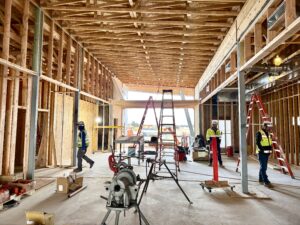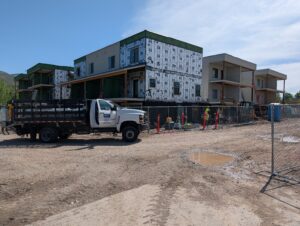Terms like ‘Green’, ‘Sustainability’ and ‘LEED’ are being thrown around lately and architects have been a big part of the throwing. In fact, at EVstudio have been discussing these terms a lot lately. So what do these terms really mean and what do they really have to do with architecture?
The word ‘Green’, as it applies to the interests of the environment, has been applied to everything from household cleansers to SUV’s to buildings over the past few years. At the same time, the terms ‘Green’ and ‘Sustainable’ have come to be somewhat synonymous when referring to design. So what do they mean? According to the General Services Administration, who overlooks all Federal building projects, green or sustainable design is defined as design that seeks to “reduce consumption of non-renewable resources, minimize waste, and create healthy, productive environments.” In addition, other common definitions expand that definition to include economic, social & ecological sustainability concerns.
So what does this have to do with architecture, then? Tons! According to the Environmental Protection Agency, there are more than 170,000 commercial buildings and more than 1.8 million residential buildings constructed every year. In addition, more than 44,000 commercial buildings are demolished annually. They did not include a statistic for the number of residential buildings demolished on an annual basis, but considering the number for commercial buildings, it is probably quite substantial. Furthermore, the study states that buildings consume more than 40% of the total raw materials globally. In the United States alone, buildings account for 39% of the annual primary energy usage and 70% of the electricity usage. The same buildings produce 39% of the total CO2 emissions (more than ALL the cars on the road!) and create more than 136 million tons of construction and demolition waste that goes into landfills and incinerators every year. Residential buildings alone account for more than half of these numbers. These statistics, however, deal only with the environmental impacts of the built environment. Economically the construction industry accounts for approximately 14% of the Gross Domestic Product (GDP) in the US and somewhere between 8% – 10% of the GDP globally. The current state of the US and global economy testifies to the validity of those numbers. Finally, to bring it down to the personal level, Americans spend 90% of their time indoors on average and the indoor environment can contain up to 200% more pollutants than the outdoors, depending on the age and type of construction.
Here at EVstudio, we believe that sustainable design is design that carefully and effectively balances all of the unique characteristics of a project including the economics, environmental issues, site opportunities and constraints, functionality and marketability into the collective ‘vision’ for the project. A project is not sustainable if it is neither affordable nor suits the specific needs of the client. With this in mind, however, we have built many of the most effective sustainable design strategies into our everyday practice. These strategies include concepts such as passive solar design, natural daylighting, and natural ventilation which take advantage of the opportunities inherent within the site. We consider these strategies and others as merely the elements of smart design that can add real value to the project. These strategies of smart design require only forethought, not additional cost. We feel a great responsibility to create the best designs possible and this includes creating built environments that are an asset, not a detriment, to the life within and around them.










